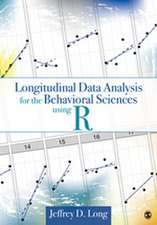Sociophysics: A Physicist's Modeling of Psycho-political Phenomena: Understanding Complex Systems
Autor Serge Galamen Limba Engleză Hardback – 10 feb 2012
Indeed, future developments and evaluation will either show sociophysics to be inadequate, thus supporting the hypothesis that people can primarily be considered to be free agents, or valid, thus opening the path to a radically different vision of society and personal responsibility. This book attempts to explain why and how humans behave much like atoms, at least in some aspects of their collective lives, and then proposes how this knowledge can serve as a unique key to a dramatic leap forwards in achieving more social freedom in the real world. At heart, sociophysics and this book are about better comprehending the richness and potential of our social interaction, and so distancing ourselves from inanimate atoms.
| Toate formatele și edițiile | Preț | Express |
|---|---|---|
| Paperback (1) | 1328.20 lei 6-8 săpt. | |
| Springer – 23 aug 2016 | 1328.20 lei 6-8 săpt. | |
| Hardback (1) | 1332.92 lei 6-8 săpt. | |
| Springer – 10 feb 2012 | 1332.92 lei 6-8 săpt. |
Din seria Understanding Complex Systems
- 18%
 Preț: 1112.30 lei
Preț: 1112.30 lei -
 Preț: 439.25 lei
Preț: 439.25 lei - 18%
 Preț: 1119.38 lei
Preț: 1119.38 lei - 15%
 Preț: 401.82 lei
Preț: 401.82 lei - 18%
 Preț: 1247.26 lei
Preț: 1247.26 lei - 15%
 Preț: 641.20 lei
Preț: 641.20 lei - 15%
 Preț: 642.68 lei
Preț: 642.68 lei - 15%
 Preț: 651.51 lei
Preț: 651.51 lei - 18%
 Preț: 946.55 lei
Preț: 946.55 lei - 18%
 Preț: 947.98 lei
Preț: 947.98 lei - 20%
 Preț: 650.27 lei
Preț: 650.27 lei - 18%
 Preț: 952.09 lei
Preț: 952.09 lei - 18%
 Preț: 957.13 lei
Preț: 957.13 lei - 18%
 Preț: 943.88 lei
Preț: 943.88 lei -
 Preț: 398.35 lei
Preț: 398.35 lei - 5%
 Preț: 1417.54 lei
Preț: 1417.54 lei - 15%
 Preț: 648.42 lei
Preț: 648.42 lei -
 Preț: 387.75 lei
Preț: 387.75 lei - 18%
 Preț: 1133.76 lei
Preț: 1133.76 lei - 18%
 Preț: 948.16 lei
Preț: 948.16 lei - 20%
 Preț: 655.85 lei
Preț: 655.85 lei - 18%
 Preț: 1113.09 lei
Preț: 1113.09 lei - 20%
 Preț: 655.53 lei
Preț: 655.53 lei - 15%
 Preț: 653.00 lei
Preț: 653.00 lei - 18%
 Preț: 1010.48 lei
Preț: 1010.48 lei - 18%
 Preț: 955.56 lei
Preț: 955.56 lei -
 Preț: 384.22 lei
Preț: 384.22 lei - 18%
 Preț: 950.66 lei
Preț: 950.66 lei - 15%
 Preț: 638.43 lei
Preț: 638.43 lei - 15%
 Preț: 644.49 lei
Preț: 644.49 lei - 15%
 Preț: 647.40 lei
Preț: 647.40 lei - 15%
 Preț: 649.06 lei
Preț: 649.06 lei - 15%
 Preț: 639.25 lei
Preț: 639.25 lei - 15%
 Preț: 643.65 lei
Preț: 643.65 lei - 18%
 Preț: 960.78 lei
Preț: 960.78 lei - 15%
 Preț: 649.87 lei
Preț: 649.87 lei - 15%
 Preț: 645.47 lei
Preț: 645.47 lei
Preț: 1332.92 lei
Preț vechi: 1625.52 lei
-18% Nou
Puncte Express: 1999
Preț estimativ în valută:
255.09€ • 265.33$ • 210.59£
255.09€ • 265.33$ • 210.59£
Carte tipărită la comandă
Livrare economică 14-28 aprilie
Preluare comenzi: 021 569.72.76
Specificații
ISBN-13: 9781461420316
ISBN-10: 1461420318
Pagini: 536
Ilustrații: XXIII, 439 p.
Dimensiuni: 155 x 235 x 33 mm
Greutate: 0.78 kg
Ediția:2012
Editura: Springer
Colecția Springer
Seria Understanding Complex Systems
Locul publicării:New York, NY, United States
ISBN-10: 1461420318
Pagini: 536
Ilustrații: XXIII, 439 p.
Dimensiuni: 155 x 235 x 33 mm
Greutate: 0.78 kg
Ediția:2012
Editura: Springer
Colecția Springer
Seria Understanding Complex Systems
Locul publicării:New York, NY, United States
Public țintă
ResearchCuprins
Part 1: Sociophysics: setting the frame.- What is sociophysics about?.- The question: do humans behave like atoms?.- Sociophysics: the origins.- Sociophysics: weaknesses, achievements and challenges.- Part II: Discovering the wonderful (and maybe scary) world of Sociophysics.- Sociophysics: an overview of emblematic founding models.- Universal features of group decision making.- The dictatorship paradox of democratic bottom-up voting.- The dynamics of spontaneous coalition-fragmentation versus global coalitions.- Terrorism and the percolation of passive supporters.- The modeling of opinion dynamics.- By way of caution.- Part III: Democratic voting in bottom-up hierarchical structures: from advantages and setbacks to dictatorship paradoxes.- Highlights of the Part.- Basic mechanisms for the perfect democratic structure.- Going to applications.- Touching on a fundamental aspect of nature, both physical and human.- Dictatorship paradoxes of Democratic voting in hierarchical structures.- Part IV: The risky business of alliances in bottom-up democratic voting with three-choice competition.- Bottom-up democratic voting in a three-choice competition.- So sorry, that's the end of the tour!.- I thank you.
Notă biografică
Serge Galam is a theoretical physicist specialized in disordered systems with doctorate degrees from Paris and Tel-Aviv. After being a research associate at the City College of New York and an assistant professor at New York University, he joined the CNRS in Paris where he is currently working at the Research Center in Applied Epistemology at the 'Ecole Polytechnique. He is the proud father of sociophysics, a new field of study that he envisioned and initiated more than thirty years ago.
He has authored over 120 research papers in the best international journals, three books, over 60 popular articles and 30 book chapters and given about 300 talks throughout the world.
He has authored over 120 research papers in the best international journals, three books, over 60 popular articles and 30 book chapters and given about 300 talks throughout the world.
Textul de pe ultima copertă
Do humans behave much like atoms? Sociophysics, which uses tools and concepts from the physics of disordered matter to describe some aspects of social and political behavior, answers in the affirmative. But advocating the use of models from the physical sciences to understand human behavior could be perceived as tantamount to dismissing the existence of human free will and also enabling those seeking manipulative skills. This thought-provoking book argues it is just the contrary.
Indeed, future developments and evaluation will either show sociophyics to be inadequate, thus supporting the hypothesis that people can primarily be considered to be free agents, or valid, thus opening the path to a radically different vision of society and personal responsibility. This book attempts to explain why and how humans behave much like atoms, at least in some aspects of their collective lives, and then proposes how this knowledge can serve as a unique key to a dramatic leap forwards in achieving more social freedom in the real world. At heart, sociophysics and this book are about better comprehending the richness and potential of our social interaction, and so distancing ourselves from inanimate atoms.
Indeed, future developments and evaluation will either show sociophyics to be inadequate, thus supporting the hypothesis that people can primarily be considered to be free agents, or valid, thus opening the path to a radically different vision of society and personal responsibility. This book attempts to explain why and how humans behave much like atoms, at least in some aspects of their collective lives, and then proposes how this knowledge can serve as a unique key to a dramatic leap forwards in achieving more social freedom in the real world. At heart, sociophysics and this book are about better comprehending the richness and potential of our social interaction, and so distancing ourselves from inanimate atoms.
Caracteristici
The first book ever that explains the field of sociophysics, written by its founding father Demonstrates the value of applying methods in physics for the modeling of social and political phenomena Presents convincing examples with correct predictions of collective human behavior Includes supplementary material: sn.pub/extras













